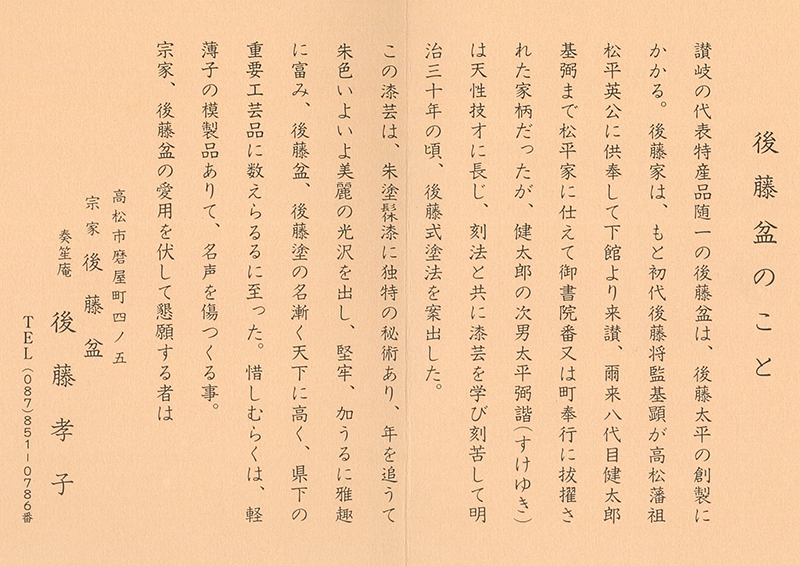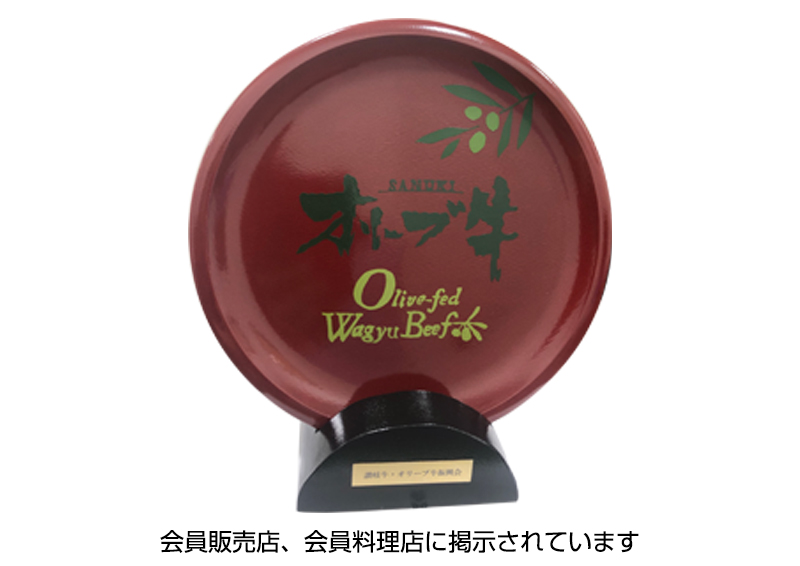


"Sanuki Wagyu" is fattened in Kagawa and is only produced from purebred cattle. According to the Japan Meat Grading Association's Carcass Trading Standards, "Sanuki Olive-fed Wagyu Beef" ranks at grade A and B for its yield and at Grade 5, 4 (Gold Label) and 3 (Silver Label) for its meat quality."Olive-fed Wagyu Beef" among "Sanuki Wagyu", refers to WAGYU produced in Kagawa Prefecture and reared on Olive feed determined by the "Sanuki Wagyu Brand Promotion Committee".
Sanuki Beef Official Meat Certificate by Olive-fed Wagyu Beef Promotion Association



香川県は知る人ぞ知る「漆芸王国」。その讃岐漆器を代表する五技法の一つが「後藤塗」。
明治二年、後藤太平(ごとう たへい)が創案。高松藩の町奉行だった父・健太郎の影響で讃岐漆芸の祖・玉楮象谷(たまかじ ぞうこく)とも親交があったという。
朱漆の上に上漆を重ね、独特の班紋を磨き出すことによって生まれる渋い色味が特徴で、使えば使うほど深みが増し、色鮮やかになる。特にお盆は、讃岐の家庭なら必ず一枚あると言ってもいいほどの定番商品。現在では、塗りの堅牢さから家庭用品や茶道具、座卓、洋家具にまで幅広く親しまれている。
「宗家後藤盆」は代々後藤塗の伝統を受け継ぐ県内唯一の専門店。コーヒーカップやカトラリーなど現代のニーズに応じて新しい商品作りにも取り組んでいる。
Anyone familiar with the lacquer arts knows that Kagawa is the “Land of Lacquerware”. Gotonuri is one of the five traditional techniques of Kagawa Lacquerware.
The Gotonuri technique was created by Goto Tahei in 1869. Under the influence of his father, Kentaro, a magistrate of the Takamatsu Clan, Goto developed a close relationship with Tamakaji Zokoku, the founding father of Kagawa Lacquerware.
Gotonuri is characterized by its elegant coloring, produced by applying layers of lacquer over vermillion lacquer and then polishing to bring out its distinctive mottled pattern. The more a Gotonuri piece is used, the deeper and more radiant its color becomes. Gotonuri trays, in particular, are a staple item in any Kagawa home, and it is safe to say that every family in Kagawa owns at least one. Currently, thanks to lacquerware’s durability, it is widely used to produce everything from household goods and tea ceremony utensils, to Japanese-style tables and western-style furniture.
Carrying on the tradition of Gotonuri for generations, Soke Goto Bon is the only shop in Kagawa specializing in Gotonuri lacquerware. This shop is also engaged in the production of new pieces, such as coffee cups and cutlery, which address the needs of contemporary consumers.